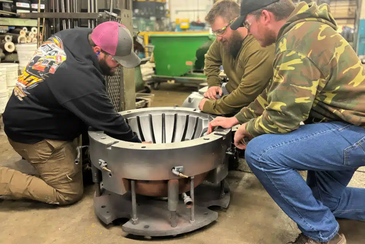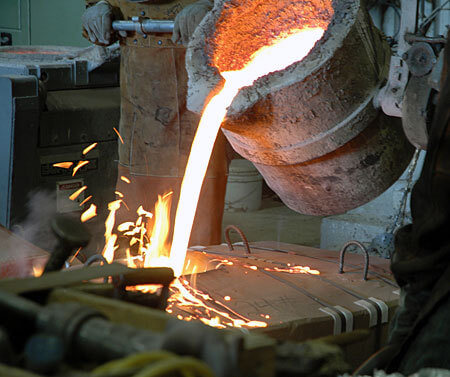Learn how Precision aluminum casting supports detailed designs in production
Wiki Article
Discovering the Ingenious Processes Behind Modern Aluminum Factory Procedures
Modern aluminum shop procedures are going through considerable improvement. Automation and AI are reshaping production techniques, enhancing both efficiency and precision. The combination of 3D printing is improving mold production, while sustainability practices are ending up being more vital. Each of these developments plays a key function in redefining the market. The implications of these modifications expand beyond simple manufacturing efficiency. What difficulties and opportunities lie in advance for aluminum foundries in this progressing landscape?The Duty of Automation in Aluminum Foundries

Moreover, automation adds to boosted security requirements within the foundry environment. By moving hazardous tasks to machines, human workers can concentrate on managerial functions and high quality control, lessening the threat of crashes. In addition, information analytics stemmed from automated procedures give useful insights into operational efficiency, causing better decision-making and continuous improvement. As the demand for light weight aluminum items grows, the fostering of automation modern technologies will likely expand, additionally transforming the landscape of aluminum foundry procedures.
Innovations in Casting Technologies
Recent innovations in casting modern technologies are changing aluminum shop operations. Innovations such as 3D printing combination, progressed alloy formulas, and automated procedure optimization are improving performance and item quality. These growths are essential in satisfying the progressing demands of the sector.3D Printing Combination
Integrating 3D printing innovation into aluminum factory procedures has transformed typical casting methods, boosting both performance and accuracy. This innovative strategy allows for the quick production of complex molds and cores, substantially lowering preparations and material waste. By utilizing additive manufacturing, factories can develop intricate geometries that were previously challenging or impossible to accomplish with conventional methods. The versatility of 3D printing also enables quick style alterations, promoting a much more dexterous production procedure. Furthermore, this combination supports the use of lightweight frameworks, which is significantly crucial in sectors such as automobile and aerospace. As aluminum shops continue to adopt 3D printing, they place themselves at the forefront of technological advancement, driving improvements in product high quality and functional capabilities.Advanced Alloy Formulations
The development of innovative alloy formulations has actually significantly enhanced casting modern technologies in aluminum foundry operations. These solutions integrate numerous elements, such as silicon, magnesium, and copper, to enhance mechanical residential or commercial properties and thermal resistance. By tailoring the composition of light weight aluminum alloys, manufacturers can achieve certain performance attributes that meet the needs of diverse applications, from automobile parts to aerospace frameworks. The usage of sophisticated alloys likewise adds to minimized weight and enhanced stamina, which are essential consider contemporary design. Furthermore, developments in alloy advancement enable far better fluidness throughout casting, leading to boosted surface coatings and reduced flaws. Overall, progressed alloy formulas represent a significant jump onward, positioning aluminum shops to meet the progressing requirements of numerous sectors efficiently.Automated Process Optimization
Developments in casting modern technologies have paved the way for automated procedure improvement in light weight aluminum factory procedures. By integrating sophisticated software application and real-time information analytics, foundries can currently streamline production procedures and boost top quality control. Automated systems monitor variables such as air conditioning, pressure, and temperature rates, enabling instant modifications that reduce problems and waste. In addition, maker learning formulas evaluate historic performance data to predict suitable setups, thereby boosting efficiency and reducing cycle times. Robotics additionally play a significant role, managing recurring tasks that improve security and precision. Generally, these innovations not only drive functional effectiveness however also enable shops to satisfy the growing demand for top notch aluminum components in various industries.Smart Manufacturing and Sector 4.0 Assimilation
The integration of Smart Production and Sector 4.0 within aluminum factories is transforming functional performance. By leveraging IoT technologies, automation, and robotics, factories can optimize manufacturing procedures and minimize downtime. Additionally, data analytics gives essential insights that boost decision-making and drive constant enhancement.IoT in Foundry Operations
As suppliers significantly embrace the Web of Points (IoT), foundry procedures are experiencing a transformative shift in the direction of clever production and Sector 4.0 integration. aluminum casting. IoT technologies make it possible for real-time information collection and analysis, boosting decision-making procedures and operational effectiveness. Sensors and linked devices keep an eye on tools efficiency, material use, and environmental problems, permitting positive maintenance and resource optimization. This connectivity cultivates an extra nimble manufacturing atmosphere, where changes can be made quickly in response to market demands. Furthermore, IoT promotes improved traceability and quality click to investigate assurance, as data from the whole manufacturing cycle can be conveniently accessed and examined. Generally, the assimilation of IoT in foundry procedures considerably enhances efficiency and drives advancement in aluminum manufacturing processesAutomation and Robotics Integration
Automation and robotics assimilation is revolutionizing light weight aluminum foundry procedures by enhancing efficiency and accuracy. This transformative approach simplifies procedures such as molding, pouring, and finishing, minimizing human error and raising result uniformity. By utilizing innovative robot systems, factories can achieve greater production rates while keeping strict high quality standards. Automated systems likewise allow real-time surveillance and adaptive control, enabling speedy modifications to production parameters. On top of that, the assimilation of robotics minimizes labor expenses and mitigates safety and security dangers related to hand-operated handling of liquified metal. As foundries embrace wise manufacturing concepts integral in Market 4.0, the harmony between automation and robotics solidifies their one-upmanship, paving the means for sustainable development and advancement in the aluminum casting market.Information Analytics for Efficiency
Utilizing information analytics substantially boosts effectiveness within aluminum shop operations, straightening with smart production and Market 4.0 principles. By leveraging real-time data collection and analysis, foundries can check production processes, predict tools failures, and enhance source allotment. This data-driven technique assists in insightful decision-making, making it possible for supervisors to enhance and identify traffic jams workflow. Furthermore, anticipating analytics empowers shops to expect market demands, thereby decreasing waste and guaranteeing prompt product delivery. Combination of information analytics with IoT tools boosts operational visibility, cultivating a proactive upkeep culture. Eventually, executing these advanced analytical strategies not only increases productivity yet additionally drives development, positioning aluminum shops to meet the developing demands of the market while keeping competitive edges in a quickly changing landscape.Lasting Practices in Aluminum Casting
While the aluminum casting market has actually generally encountered environmental difficulties, many factories are now embracing lasting methods to minimize their influence check that (Aluminum Foundry). A substantial focus has actually been on reusing aluminum scrap, which not only lowers waste yet additionally saves power contrasted to primary aluminum manufacturing. Innovative melting technologies, such as induction furnaces, enhance power effectiveness and lower greenhouse gas emissionsFurthermore, shops are applying closed-loop water systems to reduce water intake and decrease thermal contamination. The use visit this web-site of eco-friendly binders in mold-making procedures is acquiring grip, additional lowering hazardous emissions.
Some centers are spending in sustainable energy sources to power procedures, straightening with global sustainability objectives. By integrating these methods, the aluminum spreading market is progressing toward a much more eco responsible future, showing that economic development can exist together with environmental stewardship - Precision aluminum casting. These initiatives show a dedication to sustainability and the significance of environmental accountability in manufacturing
Quality Assurance Innovations
As the light weight aluminum spreading sector advances in the direction of sustainability, the significance of quality assurance innovations comes to be significantly evident. Modern light weight aluminum foundries are taking on advanced technologies to improve their quality control processes. Techniques such as real-time monitoring and information analytics enable producers to find problems and incongruities early in the production cycle. Applying automatic inspection systems equipped with device learning algorithms assurances that products satisfy rigorous top quality standards while decreasing human error.The integration of non-destructive testing techniques, such as radiographic and ultrasonic evaluations, supplies deeper insights into the integrity of castings without damaging the material. These developments not only boost product integrity however likewise decrease waste, straightening with sustainability goals. In addition, the fostering of standard top quality structures helps simplify operations throughout various foundries, ensuring uniformity in output. Jointly, these developments are improving quality control, fostering a culture of quality within the light weight aluminum casting industry.
Future Trends in Aluminum Shop Operations
What innovations exist ahead for light weight aluminum shop procedures? The future of light weight aluminum shops is positioned for improvement with innovations in automation, expert system, and lasting techniques. The assimilation of robotics and automated systems is expected to improve efficiency and accuracy in the casting processes, lowering human error and labor expenses. Additionally, AI-driven analytics will make it possible for real-time surveillance and anticipating maintenance, maximizing functional efficiency and decreasing downtime.Sustainability remains a prime focus, with foundries progressively embracing environment-friendly techniques, such as using recycled aluminum and establishing low-emission melting modern technologies. Developments in 3D printing are additionally anticipated to change mold-making, enabling intricate geometries and decreased product waste. As the industry embraces digitalization, data-driven decision-making will come to be crucial, allowing foundries to respond promptly to market demands. Jointly, these patterns promise to redefine light weight aluminum foundry procedures, making them much more effective, lasting, and versatile to future difficulties.

Frequently Asked Concerns
What Precaution Are Implemented in Light Weight Aluminum Foundry Procedures?
Light weight aluminum factory procedures apply different security procedures, including individual safety tools, ventilation systems to handle fumes, regular security training, emergency feedback plans, and strict tracking of temperature and devices to avoid mishaps and assurance employee safety and security.How Do Shops Take Care Of Workforce Educating for New Technologies?

What Materials Are Commonly Recycled in Aluminum Foundries?
Light weight aluminum foundries generally recycle scrap aluminum, including post-consumer products like beverage canisters, vehicle parts, and construction products. This reusing process minimizes waste and saves resources, contributing to a much more sustainable light weight aluminum production industry.Exactly How Does Aluminum Casting Effect the Environment?
Aluminum casting impacts the setting via energy-intensive procedures, greenhouse gas discharges, and possible regional air pollution. Advancements in reusing and sustainable techniques can minimize these effects, advertising a much more eco-friendly approach to light weight aluminum production.What Are the Normal Lead Times for Aluminum Spreading Projects?
Common preparation for aluminum casting jobs vary considerably, typically ranging from two to 6 weeks. Variables affecting these timelines include complexity, order size, and material accessibility, impacting general manufacturing schedules in factory operations.
Automation progressively plays a vital role in light weight aluminum shops, boosting effectiveness and precision in the production process. Advancements in casting technologies have paved the means for computerized procedure improvement in aluminum foundry procedures. Taking advantage of information analytics considerably boosts effectiveness within aluminum factory operations, straightening with smart production and Sector 4.0 principles. A substantial emphasis has been on recycling aluminum scrap, which not only lowers waste yet additionally saves energy compared to main light weight aluminum manufacturing. Light weight aluminum factories frequently reuse scrap light weight aluminum, consisting of post-consumer items like beverage canisters, vehicle components, and building materials.
Report this wiki page